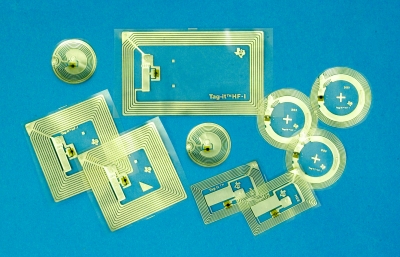Dec 14, 2005Texas Instruments (TI) announced today that it is adding two new products, as well as new memory options, security functionality and form-factor options, to its Tag-it line of ISO/IEC 15693 standard-compliant, 13.56 MHz transponders. According to Uli Denk, high-frequency RFID product marketing manager for Texas Instruments RFid Systems, a major feature of one of these tags is its ability to protect data by means of a password. This, he says, is an industry first.
The two new 13.56 MHz RFID inlays are the Tag-it HF-I Standard, with 256 bits of memory, and the Tag-it HF-I Pro, which offers password-protection functionality and is available with either 256 bits or 2 kilobits of memory. Denk says the new password and memory options will allow end users to choose the combination of security and data capacity they require for various applications.
According to Denk, TI allows its customers to customize the Standard and Pro tags by encoding and locking specific data, such as a unique ID, at the factory. The factory-locked unique ID could then be used to authenticate that the tag came from a legitimate source. This would be especially useful in the pharmaceutical supply chain, or in any industry supply chain into which counterfeit products are introduced.
With either the Standard or the Pro, users can decommission segments of the tag data for consumer protection, Denk says. When used on medicine, for example, a pharmacist could decommission the National Drug Code, an identifier maintained by the U.S. Food and Drug Administration (FDA) indicating a drug's labeler/vendor, product and package size. This could help prevent such data from being skimmed (surreptitiously read by an authorized RFID interrogator) from the tag once it is in a consumer's possession. The product's EPC or other unique identifier would remain intact, however, so the product could be identified in the event of a recall.
High-frequency tags are most commonly used for item-level tracking and authentication, library applications and ticketing in high-traffic choke points, such as lift lines in ski areas. Wolfram Kocznar, chief executive officer of Axess, a Salzburg, Austria, provider of RFID ski lift tickets, says the HF-I Pro tag's password-protected capability—which requires a user to enter a password to read or encode data—could be used by ski resorts to safeguard data such as payment credits on reusable, RFID-enabled lift tickets. This could help ensure that the credits were added to and deducted from the card by an authorized party.
Denk says TI decided to offer the 256-bit memory option after observing that some of its customers hadn't made use of the 2 kilobits on the earlier inlays. He says the 256-bit tags costs less than the 2-kilobit versions, though TI would not divulge any pricing information.
The two new tags will be available in production quantities during the first quarter of 2006. They join TI's two current 13.56 MHz transponders, the Tag-it HF-I Plus, which has 2 kilobits of memory but no password functionality, and the Tag-it HF-I RxID, which enables users to write data to the tag that is segmented and is protected with a public key infrastructure (PKI) for data encryption. Earlier this year, TI debuted the RxID inlay, designed for pharmaceutical applications requiring high data security, along with a drug-authentication model codeveloped by TI and VeriSign (see TI, VeriSign Devise Drug-Protection Plan).
All of the inlays can be integrated onto substrates of paper, PVC or other materials. They are available as circular inlays that can be incorporated into a CD or DVD, or as square or rectangular shapes.


